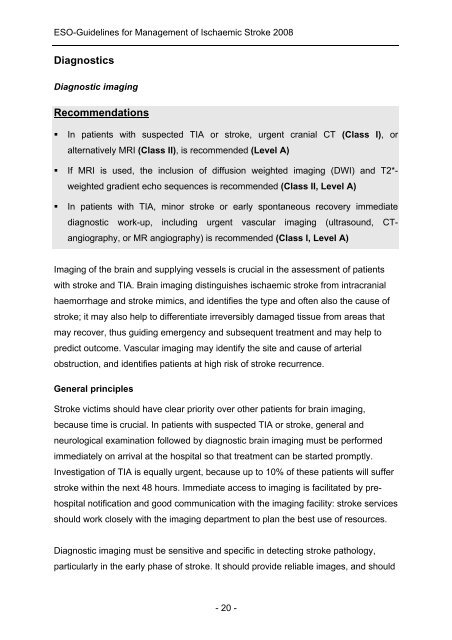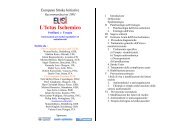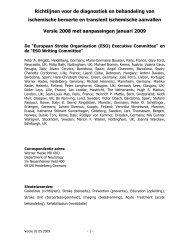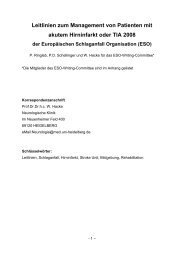Guidelines for Management of Ischaemic Stroke 2008 - ESO
Guidelines for Management of Ischaemic Stroke 2008 - ESO
Guidelines for Management of Ischaemic Stroke 2008 - ESO
You also want an ePaper? Increase the reach of your titles
YUMPU automatically turns print PDFs into web optimized ePapers that Google loves.
<strong>ESO</strong>-<strong>Guidelines</strong> <strong>for</strong> <strong>Management</strong> <strong>of</strong> <strong>Ischaemic</strong> <strong>Stroke</strong> <strong>2008</strong><br />
Diagnostics<br />
Diagnostic imaging<br />
Recommendations<br />
In patients with suspected TIA or stroke, urgent cranial CT (Class I), or<br />
alternatively MRI (Class II), is recommended (Level A)<br />
If MRI is used, the inclusion <strong>of</strong> diffusion weighted imaging (DWI) and T2*-<br />
weighted gradient echo sequences is recommended (Class II, Level A)<br />
In patients with TIA, minor stroke or early spontaneous recovery immediate<br />
diagnostic work-up, including urgent vascular imaging (ultrasound, CT-<br />
angiography, or MR angiography) is recommended (Class I, Level A)<br />
Imaging <strong>of</strong> the brain and supplying vessels is crucial in the assessment <strong>of</strong> patients<br />
with stroke and TIA. Brain imaging distinguishes ischaemic stroke from intracranial<br />
haemorrhage and stroke mimics, and identifies the type and <strong>of</strong>ten also the cause <strong>of</strong><br />
stroke; it may also help to differentiate irreversibly damaged tissue from areas that<br />
may recover, thus guiding emergency and subsequent treatment and may help to<br />
predict outcome. Vascular imaging may identify the site and cause <strong>of</strong> arterial<br />
obstruction, and identifies patients at high risk <strong>of</strong> stroke recurrence.<br />
General principles<br />
<strong>Stroke</strong> victims should have clear priority over other patients <strong>for</strong> brain imaging,<br />
because time is crucial. In patients with suspected TIA or stroke, general and<br />
neurological examination followed by diagnostic brain imaging must be per<strong>for</strong>med<br />
immediately on arrival at the hospital so that treatment can be started promptly.<br />
Investigation <strong>of</strong> TIA is equally urgent, because up to 10% <strong>of</strong> these patients will suffer<br />
stroke within the next 48 hours. Immediate access to imaging is facilitated by prehospital<br />
notification and good communication with the imaging facility: stroke services<br />
should work closely with the imaging department to plan the best use <strong>of</strong> resources.<br />
Diagnostic imaging must be sensitive and specific in detecting stroke pathology,<br />
particularly in the early phase <strong>of</strong> stroke. It should provide reliable images, and should<br />
- 20 -





